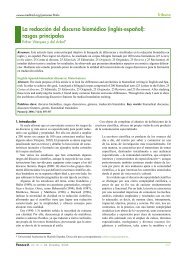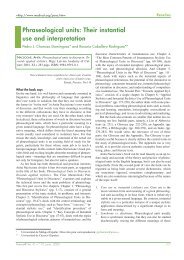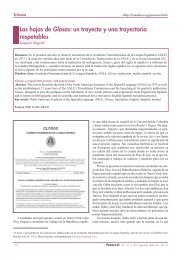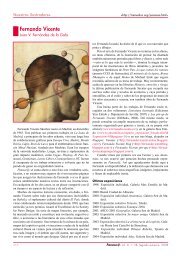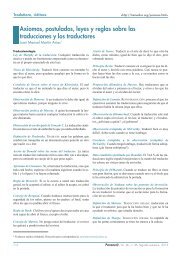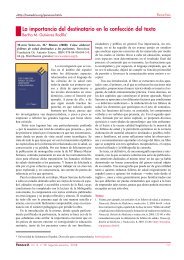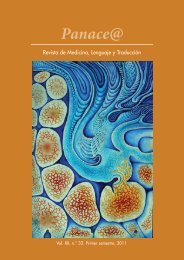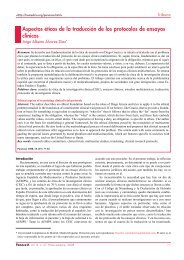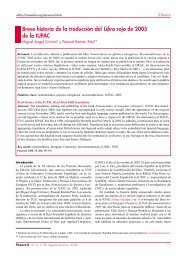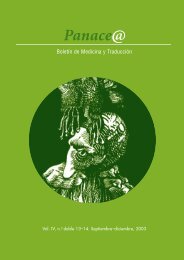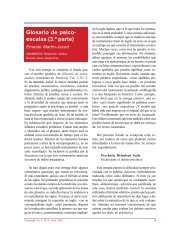You also want an ePaper? Increase the reach of your titles
YUMPU automatically turns print PDFs into web optimized ePapers that Google loves.
Reseñas<br />
Encyclopedia of Language and Linguistics<br />
Françoise Salager-Meyer *<br />
Brown, Keith (Editor-in-Chief): The Encyclopedia<br />
of Language and Liguistics (2nd edition; 14-volume<br />
set). Amsterdam: Elsevier, 2006; ca. 9,000 pages. ISBN:<br />
0-08-044299-4). Price: EUR 3,999 or USD 4,480.<br />
Also available online on ScienceDirect ().<br />
The second edition of<br />
the Encyclopedia of<br />
Language and Linguistics<br />
(ELL2) will be published<br />
in print by Elsevier<br />
in late 2005 and will<br />
be available online on<br />
Science Direct in early<br />
2006. The online version<br />
will publish updates as<br />
subjects develop.<br />
This reference work<br />
builds on foundations<br />
laid by the first edition<br />
published in 1993, edited<br />
by Ron Asher, that<br />
was hailed as “the field’s<br />
standard reference work for a generation.” It had received enthusiastic<br />
reviews and, according to its publisher, has been for<br />
a decade the most authoritative and international reference<br />
source in its field.<br />
Since the first edition, linguistics has seen an explosive<br />
growth both in its own specializations and in interdisciplinary<br />
fields. As its editor-in chief, Keith Brown (University<br />
of Cambridge, UK), remarks, ELL2 reflects the evolution of<br />
the linguistics field by being an entirely new work, with new<br />
and expanded sections, new topics, new editors, new authors<br />
and newly commissioned papers while retaining from ELL1 a<br />
handful of classic articles, mainly of historical interest.<br />
ELL2 is aimed at a wide readership: students (undergraduates<br />
and postgraduates), teachers, lecturers, researchers<br />
and professionals in a variety of disciplines who will need to<br />
seek an authoritative source of information about any particular<br />
aspect of linguistics and/or its applications.<br />
ELL2 is a 14-volume set, hardbound. It includes about<br />
7 500 000 words; 9000 pages; 3000 articles; 1500 figures (approximately<br />
150 coulour and 130 halftones); 3000 glossary definitions;<br />
39 000 references; 650 biographical entries (including<br />
contemporary linguists); over 100 language maps in print and<br />
approximately 200 on line; a list of the world languages (including<br />
information on the number of speakers, language family, etc)<br />
and audio, video, and text supplementary files online.<br />
ELL2 covers the full range of topics in contemporary linguistics.<br />
It deals with all aspects of language (spoken, written<br />
and signed) and gives full attention to formal and functional<br />
approaches to the fundamental linguistic disciplines, viz.,<br />
phonology, phonetics, morphology, syntax, lexicography,<br />
semantics, semiotics, pragmatics and discourse as they relate<br />
to the description, analysis and use of individual languages<br />
and to typological, historical, comparative and variationist<br />
approaches to languages. It pays major attention to the<br />
areas of applied linguistics, sociolinguistics, historical and<br />
comparative linguistics, psycholinguistics and text linguistics<br />
and to the interdisciplinary relations between these various<br />
disciplines and the applications of linguistics with other disciplines<br />
such as anthropology, philosophy, politics, religion,<br />
education, media, law, language pathology and neurolinguistics,<br />
medicine and computer science. It gives extensive<br />
coverage of the structure, history and use of all the major<br />
languages of the world and to a wide variety of less widely<br />
spoken languages, including endangered languages. It also<br />
contains accounts of the linguistic situation in all countries<br />
of the world.<br />
Altogether, ELL2 contains 41 different sections that cover<br />
the above mentioned topics, but two of them will be of particular<br />
interest to Panace@’s readership: the one entitled “Translation”<br />
edited by Kirsten Malmkjaer (Middlesex University,<br />
UK) and that entitled “Medicine and language”, whose editor<br />
is Françoise Salager-Meyer from the University of Merida<br />
(Venezuela).<br />
For those who could be interested, here is the outline of<br />
both sections.<br />
Translation<br />
The “Translation” section is divided into seven parts:<br />
1. General issues<br />
- Conference<br />
- History of translation<br />
- Linguistic influence<br />
- Localisation<br />
- Pedagogy of translation<br />
- Profession<br />
- Sign language interpreting<br />
- Talk aloud protocols<br />
2. Approaches to translation<br />
- Cultural colonialism and gender<br />
- Functional approaches<br />
- Linguistic approaches<br />
- Relevance theory<br />
* Graduate School of Medicine, University of the Andes, Merida (Venezuela). Address for correspondence: fmeyer@telcel.net.ve.<br />
Panace@. Vol. VI, n. o 21-22. Septiembre-diciembre, 2005 431



